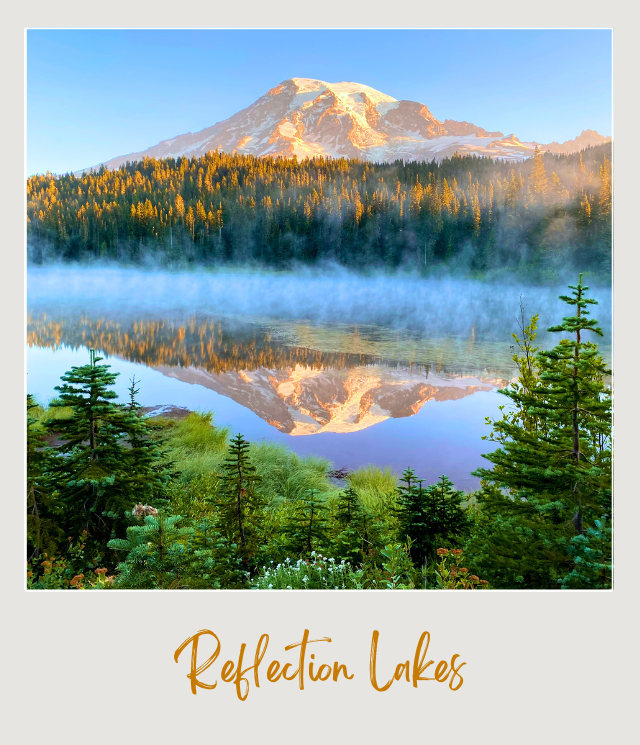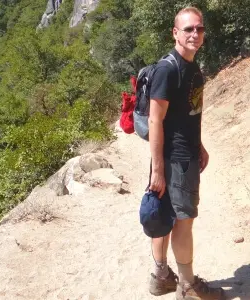If you’re feeling overwhelmed trying to plan your trip to Mount Rainier National Park, you’re not alone.
This park is beautiful – but it can also be confusing. There are multiple entrances, seasonal closures, changing weather, and very limited parking in the most popular areas. It’s easy to waste time or miss out if you’re not prepared.
That’s why I put together these 10 Tips for Visiting Mount Rainier National Park.
I’ve explored all the main sections of Mt. Rainier and I’ve learned what works, what doesn’t, and what most first-time visitors wish they’d known ahead of time.
This is for travelers who want their trip to be smooth, scenic, and stress-free. Whether you’re hiking, sightseeing, or just hoping to catch the wildflowers in bloom, these Mt Rainier tips will help you make the most of your time.
If you’re looking for practical, experience-backed Mt Rainier National Park information, let’s get going – these tips are going to change the way you plan.
Watch these tip for visiting Mount Rainier National Park on video:
🔔 You can also watch this video on YouTube directly (opens in new tab).
🎙️ Or listen as a podcast:
🛏️TOP HOTEL PICK: Check availability now
🚘FIND THE CHEAPEST CAR RENTAL: Search Discover Cars for the best deals
✈️FIND THE CHEAPEST FLIGHTS: Search Skyscanner for the best deals
🧳GET TRAVEL INSURANCE: Get insured with Travelex before you go
📱TAKE AN AUDIO TOUR: Buy an audio tour now
Table of Contents
10. Get a Timed Entry Permit

Mount Rainier National Park requires timed entry permits during peak visitor seasons for the Paradise and Sunrise sections of the park. This helps the National Park Service manage crowd levels and minimize environmental impact.
These permits are released in advance and disappear almost the second they become available, so know when they open up and grab one straight away.
➡️ Read the Mount Rainier section in my guide to US National Parks that Require Reservations for more details.
Subscribe to daily national parks planning tips, travel inspiration and trip ideas and I’ll send you a free PDF of this Guide:
10 Tips For Visiting Mount Rainier National Park
9. Be Prepared for Snow on the Trails in June – and even July

Mount Rainier is the snowiest place in the United States, receiving an average of 645 inches annually! All that snow doesn’t disappear overnight.
Which is why Mount Rainier is notorious for its lingering snow. Paradise is often blanketed in white even in the early summer months. Last year’s snow report indicated an impressive 8.5 feet of snow on the ground at the end of June.
So, if you’re visiting in July, don’t be surprised to find the main trails at Paradise still snow-covered, at least in part.
Keep an eye on the snow levels as your trip approaches to ensure you’re fully prepared for the trails. And if there is snow, wear microspikes so you don’t slip on snowy or icy trails.
➡️ If you’re looking to buy some microspikes, check out my guide to the Best Microspikes for Hiking or take a look at the ones I use.
8. Take picnic supplies with you

You may well want to spend the whole day on the beautiful trails of Mount Rainier, and with no major stores or gas stations within a 45-minute drive of the park, it’s good to be prepared.
There’s a small shop and snack bar in the Visitor Center in Paradise and the Day Use Lodge in Sunrise, but for more options, I recommend packing a picnic with your favorite snacks and a hearty lunch to enjoy amid the natural splendor.
7. Check the Mount Rainier webcams before your visit for current conditions

Weather at Mount Rainier can be unpredictable, so take advantage of the park’s webcams to check the current conditions before your visit.
While timing your trip to coincide with perfect weather may not always be possible, keeping an eye on the forecast can help you adjust your plans.
On clear days, aim to hike trails with direct views of Mount Rainier, while cloudier days are ideal for exploring the park’s forested paths where it doesn’t matter if you can’t see the mountain.
➡️ Check out different hiking options in Mount Rainier.
6. Check road closures and trail conditions on the park’s website before visiting

Stay informed about the latest road closures and trail conditions by checking the park’s official website before you head out.
Mount Rainier’s environment means that trails and roads can close unexpectedly due to weather or maintenance. By staying up-to-date, you can adjust your plans accordingly and avoid any disappointments.
5. Visit the Paradise area for wildflower meadows and panoramic views

The Mount Rainier National Park wildflowers are justifiably famous. And it’s hard to think of a place more aptly named than Paradise. The stunning wildflower meadows and sweeping views of Mount Rainier and the peaks of the Cascade Ranges are some of my favorite places on the planet.
In the summer months (July and August), the meadows burst into a riot of color, with wildflowers blooming in every direction. The area is laced with trails, from easy walks to challenging hikes. Whether you’re an avid photographer or simply a lover of natural beauty, Paradise is THE must-visit destination in the park.
The season is short – but you can still find some late blooming flowers in early September.
4. Consider visiting during the fall for vibrant autumn colors and fewer visitors

I must admit that summer is my favorite time in Mount Rainier, but fall is a very close second.
Fall drapes the landscape in a spectacular display of colors, with the foliage transforming into a tapestry of reds, oranges, and yellows. Plus, the park is generally less crowded during this season. Cooler temperatures also make for pleasant hiking conditions.
3. Start your day early

An early start at Mount Rainier can make all the difference in your park experience. Parking spots fill up quickly, even with timed entry permits, especially at popular spots like Paradise and Sunrise.
And the calm of morning on the trails is something truly special. My top picks for seeing the sunrise – or just after – are Reflection Lakes and Sunrise Point, where the first golden rays of sunlight ignite the mountain’s glaciers in a fiery glow, creating a magical spectacle.
2. Prepare for changing weather conditions

The weather on Mount Rainier is as variable as the landscape, with conditions that can shift rapidly. To stay comfortable and safe, bring a variety of layers that you can add or remove as needed.
Waterproof clothing is also essential, as rain showers can arrive unexpectedly. Even on sunny days, the temperature can be cool, especially at higher elevations, so having a warm jacket can be a lifesaver.
Gloves, a hat, and sturdy, waterproof hiking boots are also key items to include in your packing list.
1. Have a Detailed (& Flexible) Plan

To truly get the most out of your visit to Mount Rainier National Park, consider purchasing one of my detailed itineraries for Mount Rainier National Park. Available for 1-day, 2-day, and 3-day trips, these itineraries are tailored to accommodate different preferences and activity levels.
They include hour-by-hour plans, visiting tips, hike descriptions, driving directions, and the best spots for stunning views. The goal of these itineraries is to alleviate the stress of planning by providing a comprehensive guide to the park. Let me take care of the details, so you can immerse yourself in the awe-inspiring beauty of Mount Rainier without the hassle of planning every step.
➡️ Check out my detailed Mount Rainier National Park Itineraries if you want some help with your itinerary planning.
Enjoy your trip to Mount Rainier!
More Planning Resources for Mount Rainier National Park
⭐ Mount Rainier National Park Guide
⭐ Mount Rainier National Park Itineraries
⭐ Planning a Trip to Mount Rainier National Park: 7 Mistakes to Avoid
⭐ How many days in Mount Rainier National Park do you need?
⭐ Best Hikes in Mount Rainier National Park
⭐ The Skyline Trail Guide
⭐ How To Get to Mount Rainier National Park
⭐ All the Airports Near Mount Rainier National Park
⭐ The Closest Airport To Mount Rainier National Park
⭐ Best Time To Visit Mount Rainier National Park
⭐ Visiting Mount Rainier National Park: What To Expect Throughout the Year
⭐ 10 Fun Facts About Mount Rainier National Park
Do you have any other tips for visiting Mt Rainier National Park? I’d love to hear about them. Join my private Facebook group National Parks Collectors and comment and let me know (you can also pick up extra planning tips, share your photos and stories with other national park lovers and more).
Subscribe to daily national parks planning tips, travel inspiration and trip ideas and I’ll send you a free PDF of this Guide:
10 Tips For Visiting Mount Rainier National Park
If you liked these Mount Rainier travel guide tips, Pin It to your Mount Rainier National Park board!


💡 Are you just starting to think about taking a national parks trip? Get Inspiration
‼️ Are you looking for helpful tips for visiting US national parks? Read articles that share useful tips on a range of national-park related issues
💻 Are you starting to plan a trip to Mount Rainier National Park? Read my Guide to Mount Rainier National Park
📋 Do you want a ready-made super detailed plan for your trip to Mount Rainier? Get a detailed 1 – 3-day Mt Rainier National Park Itinerary
💲 Are you ready to book your trip? Use these Planning and Booking Resources
📖 Do you want to read a book about US national parks? Check out my Recommended Reading Lists
About the Author

James Ian is a national park, camping and hiking expert.
He has dedicated his life to travel, visiting more than 80 countries, all 7 continents and most of the national parks in the United States. With over 35 years experience in the travel industry, James has worked on cruise ships, at resorts and hotels, and as a travel planner who’s helped hundreds of people plan successful trips to US national parks.
Based on his experience visiting our national parks multiple times, in-depth research and expertise as a travel planner, James has published detailed itineraries for many of the major national parks in the US. These itineraries, as well as in-depth park guides, and other resources will help you have your own incredible trip to US national parks without stress and hassle.
As a national park expert, James has contributed to many publications, including USA Today, Newsweek, Time Business News, Savoteur, Best Trip, and Wired.
I’m a member of the Amazon Services LLC Associates Program. As an Amazon Associate I earn from qualifying purchases.




